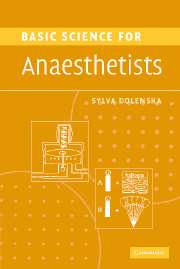Book contents
- Frontmatter
- Contents
- List of abbreviations and symbols
- List of figure captions
- Forewords
- Preface
- Preface to the second edition
- Part 1 Physics, mathematics, statistics, anaesthetic apparatus
- Part 2 Clinical measurement
- Part 3a Physiology: the cardiovascular system
- Part 3b Physiology: the respiratory system
- Part 4 Pharmacology
- Further Reading
- Index
Preface
Published online by Cambridge University Press: 13 August 2009
- Frontmatter
- Contents
- List of abbreviations and symbols
- List of figure captions
- Forewords
- Preface
- Preface to the second edition
- Part 1 Physics, mathematics, statistics, anaesthetic apparatus
- Part 2 Clinical measurement
- Part 3a Physiology: the cardiovascular system
- Part 3b Physiology: the respiratory system
- Part 4 Pharmacology
- Further Reading
- Index
Summary
There are many textbooks to chose from when preparing for the FRCA examination; the candidate suffers not from lack of information but rather from being inundated with it. The candidate then has the task of information sorting and data compression to memorize and utilize all this information. Graphic representation of data is an excellent form of data compression; figures or drawings are frequently asked about at the viva examination, particularly since the candidate's understanding of a problem comes across most clearly when drawing a figure or a using a picture. For anaesthetists whose first language is not English, figures are also a good way of approaching a topic – I certainly find it easier to find words when describing a plot.
I constructed parts of this book when revising for the Primary Examination and afterwards when preparing tutorials. The book differs from most in that the text accompanies the pictures, rather than the pictures complementing the text. In many cases, the text is simply a legend to the figure or diagram, expanded by background information. For this reason, the figures are described only by the names of the axes and their units along with identification of any other important lines and symbols. The layout – each page of text opposite the relevant figure(s) – conveys the essential link between picture and text, and I hope it makes orientation and understanding easier.
Not all knowledge required for the FRCA (Primary or Final) is suitable for graphical representation.
- Type
- Chapter
- Information
- Basic Science for Anaesthetists , pp. xxi - xxiiPublisher: Cambridge University PressPrint publication year: 2006



